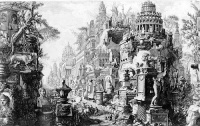Classical antiquity
From The Art and Popular Culture Encyclopedia
| Revision as of 15:07, 19 June 2010 Jahsonic (Talk | contribs) ← Previous diff |
Revision as of 11:06, 23 June 2010 Jahsonic (Talk | contribs) Next diff → |
||
| Line 25: | Line 25: | ||
| In the 18th and 19th centuries reverence for classical antiquity was much greater in [[Western Europe]] and the [[United States]] than it is today. | In the 18th and 19th centuries reverence for classical antiquity was much greater in [[Western Europe]] and the [[United States]] than it is today. | ||
| "Classical antiquity", then, is the contemporary vision of Greek and Roman culture by their admirers from the more recent past. It remains a vision that many people in the twenty-first century continue to find compelling. | "Classical antiquity", then, is the contemporary vision of Greek and Roman culture by their admirers from the more recent past. It remains a vision that many people in the twenty-first century continue to find compelling. | ||
| + | ==Subtopics== | ||
| + | '''Geographical''': | ||
| + | *[[Ancient Greece]] | ||
| + | *[[Hellenistic Greece]] | ||
| + | *[[Ancient Rome]] | ||
| + | *[[Dacia]] | ||
| + | *[[Roman Dacia]] | ||
| + | *[[Roman Britain]] | ||
| + | *[[Hispania]] | ||
| + | *[[Macedon|Ancient Macedonia]] | ||
| + | *[[Ancient Troy]] | ||
| + | *[[Gaul]] | ||
| + | *[[Ancient history of Cyprus]] | ||
| + | *[[Carthage]] | ||
| + | *[[The Balkans in classical antiquity]] | ||
| + | *[[Late Antiquity]] | ||
| + | |||
| + | '''Topical:''' | ||
| + | *[[Classical architecture]] | ||
| + | *[[Classical order]] | ||
| + | *[[Classical education]] | ||
| {{GFDL}} | {{GFDL}} | ||
Revision as of 11:06, 23 June 2010

Illustration: Antichita Romanae (1748) by Piranesi
|
Related e |
|
Featured: |
Classical antiquity (also the classical era or classical period) is a broad term for a long period of cultural history centered on the Mediterranean Sea, which begins roughly with the earliest-recorded Greek poetry of Homer (8th–7th century BC), and continues through the rise of Christianity and the decline of the Roman Empire (5th century). It ends with the dissolution of classical culture at the close of Late Antiquity (300-600), or, using the similar and better-known periodization of history, with the Early Middle Ages (500-1100).
Such a wide sampling of history and territory covers many disparate cultures and periods. "Classical antiquity" typically refers to an idealized vision of later people of what was, in Edgar Allan Poe's words, "the glory that was Greece, the grandeur that was Rome!"
Revivalism
Respect for the ancients of Greece and Rome affected politics, philosophy, sculpture, literature, theater, education, and even architecture and sexuality.
In politics, the presence of a Roman Emperor was felt to be desirable long after the empire fell. This tendency reached its peak when Charlemagne was crowned "Roman Emperor" in the year 800, an act which led to the formation of the Holy Roman Empire. The notion that an emperor is a monarch who outranks a mere king dates from this period. In this political ideal, there would always be a Roman Empire, a state whose jurisdiction extended to the entire civilized western world.
Epic poetry in Latin continued to be written and circulated well into the nineteenth century. John Milton and even Arthur Rimbaud got their first poetic education in Latin. Genres like epic poetry, pastoral verse, and the endless use of characters and themes from Greek mythology left a deep mark on Western literature.
In architecture, there have been several Greek Revivals, which seem more inspired in retrospect by Roman architecture than Greek. Still, one needs only to look at Washington, DC to see a city filled with large marble buildings with façades made out to look like Roman temples, with columns constructed in the classical orders of architecture.
In philosophy, the efforts of St Thomas Aquinas were derived largely from the thought of Aristotle, despite the intervening change in religion from Hellenic Polytheism to Christianity. Greek and Roman authorities such as Hippocrates and Galen formed the foundation of the practice of medicine even longer than Greek thought prevailed in philosophy. In the French theater, tragedians such as Molière and Racine wrote plays on mythological or classical historical subjects and subjected them to the strict rules of the classical unities derived from Aristotle's Poetics. The desire to dance like a latter-day vision of how the ancient Greeks did it moved Isadora Duncan to create her brand of ballet.
The Renaissance discovery of Classical Antiquity is a book by Roberto Weiss on how the renaissance was partly caused by the rediscovery of classic antiquity.
In the 18th and 19th centuries reverence for classical antiquity was much greater in Western Europe and the United States than it is today. "Classical antiquity", then, is the contemporary vision of Greek and Roman culture by their admirers from the more recent past. It remains a vision that many people in the twenty-first century continue to find compelling.
Subtopics
Geographical:
- Ancient Greece
- Hellenistic Greece
- Ancient Rome
- Dacia
- Roman Dacia
- Roman Britain
- Hispania
- Ancient Macedonia
- Ancient Troy
- Gaul
- Ancient history of Cyprus
- Carthage
- The Balkans in classical antiquity
- Late Antiquity
Topical:


